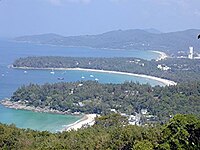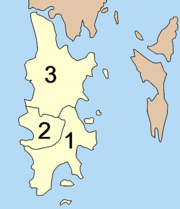- Phuket Province, which covers the complete island plus a few small neighboring islands
- Phuket (city), the main town in the southeast of the island
- Amphoe Mueang Phuket, the district covering the south of the island around Phuket town
- Monthon Phuket, a cluster of provinces covering all the western coastal provinces, dissolved in 1933

Phuket (Thai: ภูเก็ต, IPA: [pʰuːkɛt]; formerly known as Tha-Laang or Talang, or Junk Ceylon in Western sources, a distortion of the Malay Tanjung Salang, i.e. "Cape Salang")[1] is one of the southern provinces (changwat) of Thailand. Neighbouring provinces are (from north clockwise) Phang Nga and Krabi, but as Phuket is an island there are no land boundaries.
 Phuket, which is approximately the size of Singapore, is Thailand’s largest island. The island is connected to mainland Thailand by a bridge. It is situated off the west coast of Thailand in the Andaman Sea. Phuket formerly derived its wealth from tin and rubber, and enjoyed a rich and colorful history. The island was on one of the major trading routes between India and China, and was frequently mentioned in foreign ship logs of Portuguese, French, Dutch and English traders. The region now derives much of its income from tourism.
Phuket, which is approximately the size of Singapore, is Thailand’s largest island. The island is connected to mainland Thailand by a bridge. It is situated off the west coast of Thailand in the Andaman Sea. Phuket formerly derived its wealth from tin and rubber, and enjoyed a rich and colorful history. The island was on one of the major trading routes between India and China, and was frequently mentioned in foreign ship logs of Portuguese, French, Dutch and English traders. The region now derives much of its income from tourism.
Name
The name Phuket (of which the ph sound is an aspirated p) is apparently derived from the word bukit (Jawi: بوكيت) in Malay which means hill, as this is what the island appears like from a distance. The region was formerly referred to as "Thalang," derived from the old Malay "Telong" (Jawi: تلوڠ) which means "Cape." The northern district of the province, which was the location of the old capital, still uses this name.
History

In the 17th century, the Dutch, the English, and from the 1680s the French, competed with each other for trade with the island of Phuket (the island was named Junk Ceylon at that time), which was valued as a very rich source of tin. In September 1680, a ship from the French East India Company visited Phuket and left with a full cargo of tin. In 1681 or 1682, the Siamese king Narai, who was seeking to reduce Dutch and English influence, named Governor of Phuket the French medical missionary Brother René Charbonneau, a member of the Siam mission of the Société des Missions Etrangères. Charbonneau held the position of Governor until 1685.[2]
In 1685, king Narai confirmed the French tin monopoly in Phuket to a French ambassador, the Chevalier de Chaumont.[3] Chaumont's former maître d'hôtel Sieur de Billy was named governor of the island.[4] The French were expelled from Siam in 1688 however, following the 1688 Siamese revolution. On April 10, 1689, the French general Desfarges led an expedition to re-capture the island of Phuket in an attempt to restore some sort of French control in Siam.[5] The occupation of the island led nowhere, and Desfarges returned to Pondicherry in January 1690.[6]
The Burmese attacked Phuket in 1785. Captain Francis Light, a British East India Company captain passing by the island, sent word to the local administration that he had observed Burmese forces preparing to attack. Than Phu Ying Chan, the wife of the recently deceased governor, and her sister Mook(คุณมุก) then assembled what forces they could. After a month-long siege, the Burmese were forced to retreat March 13, 1785. The two women became local heroines, receiving the honorary titles Thao Thep Krasatri and Thao Si Sunthon from King Rama I. During the reign of King Chulalongkorn (Rama V), Phuket became the administrative center of the tin-producing southern provinces. In 1933 Monthon Phuket (มณฑลภูเก็ต)was dissolved and Phuket became a province by itself. Old names of the island include Ko Thalang.
Geography
 Map of Phuket (beaches in brown) | |
| Geography | |
|---|---|
| Location | Andaman Sea |
| Coordinates | 7°53′24″N 98°23′54″E / 7.89°N 98.39833°E |
| Area | 543.0 square kilometres (209.7 sq mi) |
| Length | 50 kilometres (31 mi) |
| Width | 20 kilometres (12 mi) |
| Highest point | Mai Thao Sip Song (529 metres (1,740 ft)) |
| Country | |
| Thailand | |
| Demographics | |
| Ethnic groups | Thai, Malay |

Phuket is the biggest island in Thailand, located in the Andaman Sea of southern Thailand. The island is mostly mountainous with a mountain range in the west of the island from the north to the south. The mountains of Phuket form the southern end of the Phuket mountain range, which ranges for 440 km from the Kra Isthmus. The highest elevation of the island is Mai Thao Sip Song (Twelve Canes), at 529 m above sea level.
It is estimated that Phuket has a total area of approximately 570 square kilometers (including the provinces other islands). Phuket is approximately 536 miles (862 kilometers) south of Bangkok, and covers an area of approximately 134,178 acres (543 square kilometers) excluding small islets. It is estimated that if all its 39 other small islands are included, Phuket Province will cover an area of approximately 145,792 acres (590 square kilometers). The island total length, from north to south, is estimated at 30 miles (48.7 kilometers) and 13 miles (21.3 kilometers) wide.[7]
Phuket's topology is exceptional with 70 percent of its area covered with mountains which stretch from north to south and the remaining 30 percent being plains located in the central and eastern parts of the island. The island does not have any major rivers except for a total of 9 brooks and creeks.
Forest, rubber and palm oil plantations cover 60% of the island.[citation needed] The western coast has several sandy beaches, while on the east coast beaches are more often muddy. Near the southernmost point is Laem Promthep (Brahma's Cape), which is a popular sunset viewing point. In the mountainous north of the island is the Khao Phra Thaeo Non-hunting Area, protecting more than 20 km² of rainforest. The three highest peaks of this reserve are the Khao Prathiu (384 m), Khao Bang Pae (388 m) and Khao Phara (422 m). The Sirinat National Park on the northwestern coast was established in 1981 and protects an area of 90 km² (68 km² marine area), including the Nai Yang beach where sea turtles lay their eggs.
One of the most popular tourist areas on Phuket is Patong Beach on the central western coast, perhaps owing to the easy access to its wide and long beach. Most of Phuket's nightlife and its cheap shopping is located in Patong, and the area has become increasingly developed. Patong means "the forest filled with banana leaves" in Thai. Other popular beaches are located south of Patong. In a counterclockwise direction these include Karon Beach, Kata Beach, Kata Noi Beach, and around the southern tip of the island, Nai Harn Beach and Rawai. To the north of Patong are Kamala Beach, Surin Beach and Bang Tao Beach. These areas are generally much less developed than Patong, and sought out by individuals, families and other groups with a preference for more relaxed and less crowded environs than Patong. There are many islands to the southeast, including Bon Island, just a short boat trip away. There are several coral islands to the south of Phuket, the Similan Islands lie to the north west, and Phi Phi Islands to the south east. Islanders engage in a lively tourist trade, catering to snorkellers and scuba divers.
Administrative divisions

Phuket is divided into 3 districts (Amphoe), which are further subdivided into 17 subdistricts (tambon) and 103 villages (muban).
- Mueang Phuket
- Kathu
- Thalang
There are 9 municipal (thesaban) areas within the province. The capital Phuket has city (thesaban nakhon) status, and the main touristical town Patong as well as Kathu has town (thesaban mueang) status. There are further 6 subdistrict municipalities (thesaban tambon) - Karon, Thep Krasattri, Choeng Thale, Ratsada, Rawai and Wichit. The non-municipal areas are administrated by 9 tambon administrative organizations (TAO).
Climate
Phuket has a tropical climate with a dry season from November to April and a rainy season from May to October. Average temperatures are consistent year-round. Average highs range from 29 °C (84 °F) to 33 °C (91 °F); average lows range from 23 °C (73 °F) to 26 °C (79 °F).




0 comments:
Post a Comment